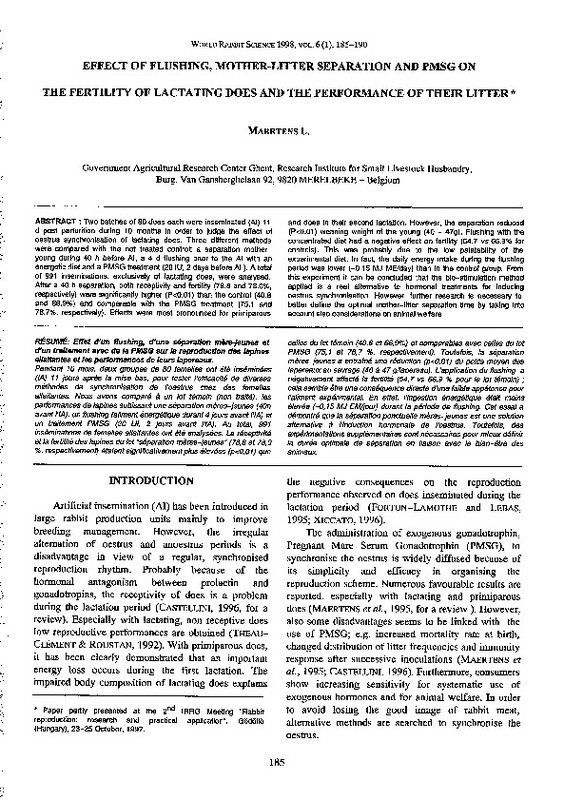JavaScript is disabled for your browser. Some features of this site may not work without it.
Buscar en RiuNet
Listar
Mi cuenta
Estadísticas
Ayuda RiuNet
Admin. UPV
EFFECT OF MOTHER-LITTER SEPARATION AND PMSG ON THE FERTILITY OF LACTATING DOES AND THE PERFORMANCE OF THEIR LITTER
Mostrar el registro sencillo del ítem
Ficheros en el ítem
| dc.contributor.author | MAERTENS, L.
|
|
| dc.date.accessioned | 2011-03-16T12:04:16Z | |
| dc.date.available | 2011-03-16T12:04:16Z | |
| dc.date.issued | 1998 | |
| dc.identifier.issn | 1257-5011 | |
| dc.identifier.uri | http://hdl.handle.net/10251/10397 | |
| dc.description.abstract | [EN] Two batches of 80 does each were inseminated (Al) 11 d post parturition during 1 O months in arder to judge the effect of oestrus synchronisation of lactating does. Three different methods were comparad with the not treated control: a separation motheryoung during 40 h befare Al, a 4 d. flushing prior to the Al with an energetic diet and a PMSG treatment (20 IU, 2 days befare Al ). A total of 991 inseminations, exclusively of lactating does, were analysed. After a 40 h separation, both receptivity and fertility (78.8 and 78.0%, respectively) were signlficantly higher (P<0.01) than the control (40.8 and 66.9%) and comparable with the PMSG treatment (75.1 and 76.7%, respectively). Effects were most pronounced for primiparous and does in their second lactation. However, the separation reduced (P<0.01) weaning weight of the young (40 - 47g). Flushing with the concentrated diet had a negativa effect on fertility (54. 7 vs 66.9% for controls). This was probably due to the low palatability of the experimental diet. In fact, the daily energy intake during the flushlng period was lower (-0.15 MJ ME/day) than in the control group. From this experiment it can be concluded that the bio-stimulation method applied is a real alternativa to hormonal treatments for inducing oestrus synchronisation. However, further research is necessary to better define the optimal mother-litter separation time by taking into account also considerations on animal welfare | es_ES |
| dc.description.abstract | [FR] Pendant 10 moís, deux groupes de 80 feme/les ont été inséminées (/A) 11 jours apres la mise bas, pour testar l'efficacité de diversas méthodes de synchronísation de l'oestrus chez des feme/les allaitantes. Nous avons comparé a un lot témoin (non traité), les performances de lapines subissant une séparation meres-jeunes (40h avant l'/A), un flushing (allment énergétique durant 4 jours avant l'IA) et un traitement PMSG (20 Uf, 2 jours avant l'IA). Au total, 991 ínséminations de feme/les allaitantes ont été ana/ysées. La réceptivité et la fertilité des tapines du lot "séparatíon meres-jeunes" (78,8 et 78,0 %, respectívement) étaient significativement plus élevées (p<0,01) que ce/les du lot témoin (40,8 et 66,9%) et comparables avec ce/les du lot PMSG (75, 1 et 76, 7 %, respectivement). Toutefois, la séparation meres-jeunes a entrainé une réductíon (p<0,01) du poids mayen des lapereaux au sevrage (40 a 47 g/lapereau). L'application du flushing a négativement affecté la fertilíté (54,7 vs 66,9 % pour le lot témoin) ; cela semble etre une conséquence directa d'une faible appétence pour /'aliment expérimental. En effet, l'ingestion énergétique était moins élevée (-0, 15 MJ EM/jour) durant la période de flushing. Cet essai a démontré que la séparation ponctuelle meres-jeunes est une solution altemative a l'induction hormona/e de l'oestrus. Toutefois, des expérimentations supplémentaires sont nécessaíres pour mieux définir la durée optimate de séparation en liaison avec le bien-etre des animaux. | |
| dc.language | Inglés | es_ES |
| dc.publisher | World Rabbit Science. ICTA. UPV | es_ES |
| dc.relation.ispartof | World Rabbit Science | |
| dc.rights | Reserva de todos los derechos | es_ES |
| dc.title | EFFECT OF MOTHER-LITTER SEPARATION AND PMSG ON THE FERTILITY OF LACTATING DOES AND THE PERFORMANCE OF THEIR LITTER | es_ES |
| dc.type | Artículo | es_ES |
| dc.date.updated | 2011-03-15T11:51:39Z | |
| dc.identifier.doi | 10.4995/wrs.1998.340 | |
| dc.rights.accessRights | Abierto | es_ES |
| dc.description.bibliographicCitation | Maertens, L. (1998). EFFECT OF MOTHER-LITTER SEPARATION AND PMSG ON THE FERTILITY OF LACTATING DOES AND THE PERFORMANCE OF THEIR LITTER. World Rabbit Science. 06(1). https://doi.org/10.4995/wrs.1998.340 | es_ES |
| dc.description.accrualMethod | SWORD | es_ES |
| dc.relation.publisherversion | https://doi.org/10.4995/wrs.1998.340 | |
| dc.description.volume | 06 | |
| dc.description.issue | 1 | |
| dc.identifier.eissn | 1989-8886 | es_ES |








